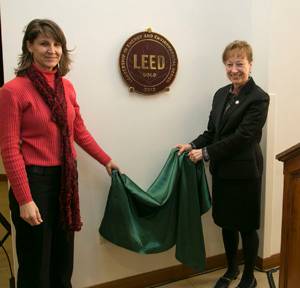Texas State, Green Building Council celebrate LEED Gold certification
Posted by Jayme Blaschke
University News Service
January 29, 2014
|
Pam Bixby Losefsky, executive director of the U.S. Green Building Council, and Denise Trauth, president of Texas State, unveil the North Campus Housing Complex’s LEED Gold certification Jan. 29. (Photo by Chandler Prude)
|
Texas State University President Denise Trauth celebrated the North Campus Housing Complex's receipt of Gold LEED (Leadership in Energy and Environmental Design) certification by the United States Green Building Council (USGBC) during a ceremony Jan. 29.
Pam Bixby Losefsky, executive director of the U.S. Green Building Council, presented the plaque of recognition during the event at Texas State. The Gold certification recognizes the university’s dedication to sustainability, energy efficiency, water conservation and air quality. Not only is it the first Gold LEED certification for Texas State, it is also the first for the entire Texas State University System.
"When we dedicated this building in August 2012, we were thrilled to add this beautiful student housing complex because it allowed us to expand on our mission of keeping freshman connected to the campus," Trauth said. "Today, we are just as thrilled to announce that this residential complex has been LEED certified at the Gold level by the U.S. Green Building Council, making it the first building in the entire Texas State University System to be so designated."
According to the USGBC, LEED is a "voluntary, consensus-based, market-driven program that provides third-party verification of green buildings." An organization’s participation "demonstrates leadership, innovation, environmental stewardship and social responsibility." LEED offers a framework for establishing efficient and sustainable solutions in the design and maintenance of new construction.
In collaboration with the Office of Facilities Planning at Texas State, the Department of Housing and Residential Life's goals for the north side complex were to construct a student residential complex with minimal impact on the environment and to provide a safe, clean home for 612 students. Of the materials used, more than 30 percent contain recycled content and more than 35 percent are from regional sources. In addition, 77 percent of construction waste was recycled.
"This complex incorporates advanced cooling and heating systems, and better building materials and windows to make the twin residence halls more energy efficient," Trauth said. "And the design and orientation of the building is such that it maximizes the use of natural light to minimize the need for artificial lighting."
In an effort to keep residents healthy, the department used low emitting materials during construction reducing the volatile off-gassing chemicals (VOCs) found in many new buildings. Walk-off mats were installed at exterior doors to control the dust and dander being carried into the buildings. In addition, light occupancy sensors are used in lounges and study rooms to decrease unnecessary electricity usage.
Current residents enjoy their new home while sharing in water and energy conservation efforts. A 40,000 gallon tank is situated in the courtyard and collects condensation from the air-conditioning system, as well as from rain run-off. The collected water is used to irrigate the almost three acres of property that surrounds the complex, which has been landscaped with native Texas plant materials.
In addition, community-style bathrooms are designed to curb water consumption. Showerheads use only 1.8 gallons of water per minute and faucets use 0.5 gallons of water per minute. Toilets use only 1.6 gallons of water per flush.
The two residence halls--Gaillardia and Chautauqua--are the first in a series of residential communities to be constructed at Texas State. The West Campus Housing Complex is now under construction. Those two new residential communities are scheduled to open for the 2014-15 academic year. The department plans to continue utilizing green-building practices in all new projects and hopes these halls will inspire residents to be better stewards of the environment.
